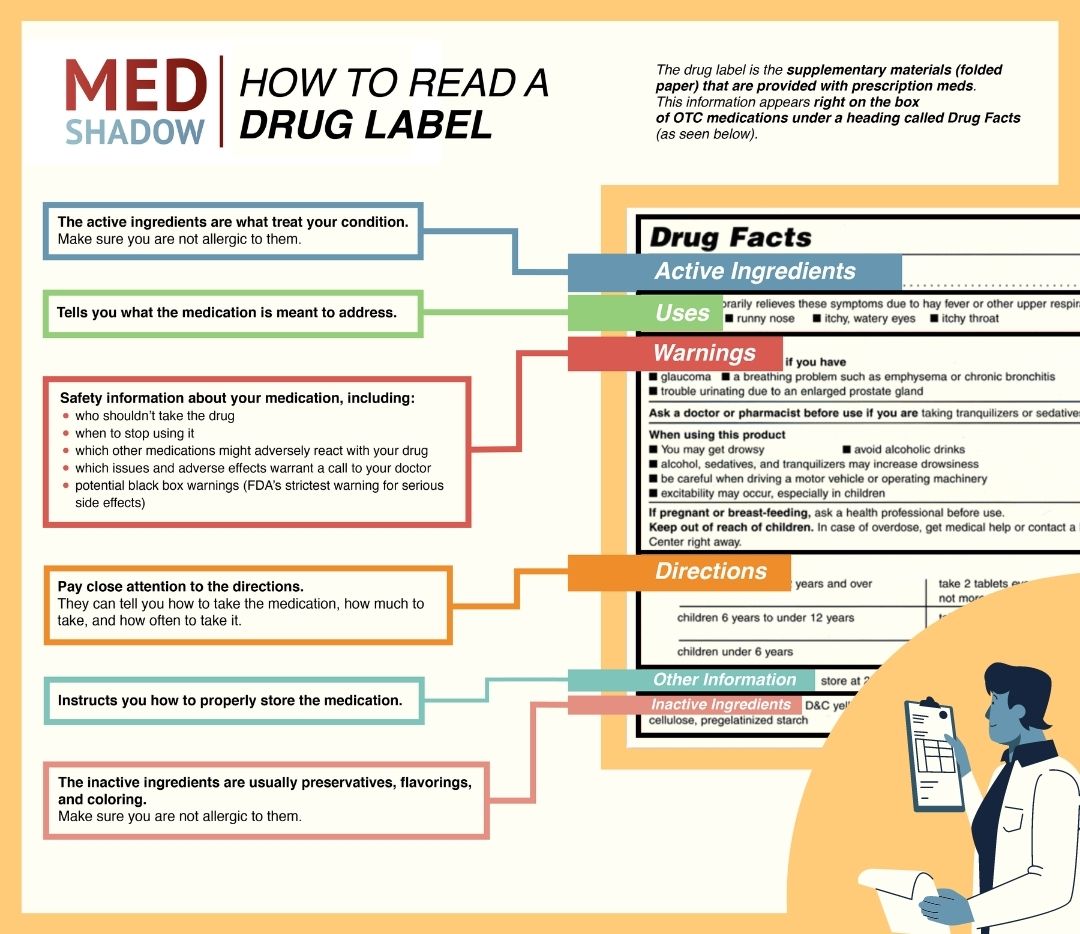Drug labels are loaded with information, and they’re admittedly not the most riveting reads. But the instructions, warnings and other details you’ll find on labels are there for your safety. So, it pays to read and comprehend the info as best you can.
To learn more about drug labels, including what you should absolutely read and what you might be able to skip, we enlisted Ohiole Kingsley Ohikuare, PharmD, a staff pharmacist at New York-Presbyterian Brooklyn Methodist Hospital.
What to Read on a Drug Label
Note that the following items typically appear right on the box of over-the-counter medications, while they can be found in the supplementary materials that are provided with prescription meds.
The Name
This one seems obvious, but it’s important to learn the name of your prescription, and to note that the name the doctor gives you verbally during an office visit could vary from the name on the prescription label, as generics are often substituted for name-brand medications. It’s a good idea to check with the pharmacist that you have the right drug (“This is amlodipine, for high blood pressure, right?) because many drugs have similar names and are easily confused.
Active Ingredients
“You need to know what you’re taking,” says Ohikuare, “and the active ingredients are what will treat your condition.” They are also what can cause side effects. Talk to your doctor and pharmacist to ensure that you’re not allergic to any of the active ingredients and that you have an idea of what side effects might occur.
Inactive Ingredients
Ohikuare mentions that this section is less important than the active ingredients, but it’s still helpful to know the inactive ingredients—which might include preservatives or
flavorings—primarily for allergy reasons. Give this section a skim to make sure you can safely take the medication.
Uses
You don’t take ibuprofen for allergies, just like you don’t take Benadryl for body aches. What are you using the drug for, and are you taking it for the right reasons? This section will help you answer those questions, and will tell you exactly what the medication is meant to address.
Directions
Always pay close attention to the directions, advises Ohikuare. For example, how to take the medication, how much to take, and how often to take it. Many drugs, particularly OTC
medications, can be taken “as needed,” but you should still follow the recommended dosage for total amount allowed per day. Some prescriptions are also taken as needed, while others must be taken at specific durations and until they’re gone. “This is where you’ll learn exactly when and how to take your medicine,” says Ohikuare.
Warnings
Here’s where you’ll find safety information about your medication, including who shouldn’t take the drug, when to stop using it, which other medications might adversely react with your drug, and which issues and adverse effects warrant a call to your doctor.
Ohikuare says to pay attention to potential side effects, so you know what to look for if you react negatively to a medication, and that bold lettering indicates more worrisome side effects. Also note if the drug carries a black box warning, as this is the FDA’s strictest notice that cautions of serious side effects, including those that can be fatal.
Expiration
This one’s easy. Look for the expiration date, and don’t take anything that’s expired. It may not be dangerous, but it also may not be as effective as what you need.
Other Information
If a medication includes a section for “other information,” it’s often to instruct you how to properly store it. In most cases, medications can be safely stored at room temperature, says Ohikuare, but occasionally something needs to be kept in fridge. If you don’t store it correctly, stability can degrade and reduce your medication’s effectiveness.
A visual review of this information can be seen in the graphic below:

What can you skip?
Labels contain a lot of information, and that can get confusing or overwhelming. Ohikuare admits that not everyone necessarily needs to know everything on a label, but it’s always worth reading. When in doubt, you should read how and when to use your medication, as well as possible adverse effects, at a minimum. However, he notes that you can skip the jargon that comes with branded patient leaflets, as they’re often loaded with studies and marketing speak.
And if you have a question or lose the label, you can always call your pharmacist. “When in doubt, don’t guess, just call your pharmacist and ask,” notes Ohikuare.
What happens if labels go digital?
Knowing exactly what you’re taking and what it does will always be important. So having access to that information is vital. Currently, there is a push by big pharma to scrap paper labels and direct people online. There’s a fear that doing so will disproportionately affect people without easy access to the Internet. Ohikuare specifically mentions the elderly, who may not feel comfortable navigating the digital landscape, and also notes that certain communities just don’t have the same access to digital information as others.
“I do see the convenience, but I don’t think it’s going to be beneficial for certain populations who aren’t comfortable accessing information online,” he says.






